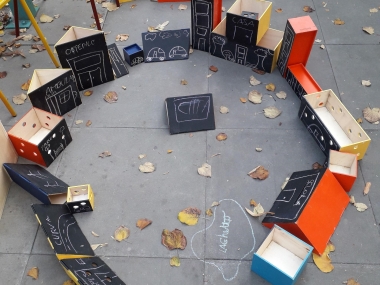Children friendly spaces matter: a creative lab
Edited on
05 September 2022Is urban mobility really children friendly? Children are key citizens of our cities, but they are rarely engaged in the planning and design of the spaces they live. Parma organised a workshop – a creative lab – for children of the neighbourhood Oltretorrente to explore their ideas and experiences of mobility and try and look at the neighbourhood through the eyes of children.

The workshop was organised for children from six years of age, with a playful approach to allow children to have fun, express themselves creatively, but also stimulate curiosity and reflection on mobility. The tool used for the lab was Snail - mobile urban laboratory for open creative activities, an itinerant participatory installation, contained in four trailers that can be towed by bicycle and composed of three-dimensional wooden modules of different shapes, colours and sizes, with which children can build and represent the city and its daily spaces, desired or imaginary.
The objective of this activity was to stimulate a playful reflection on their experience of mobility in the neighbourhood, to talk about ideas and desires, to compare one's experience with that of other children, to get in touch with different experiences of mobility.
We could understand that most of the children cycle or walk in the neighbourhood, to school or to the nearest park. Children particularly appreciate the bicycle because it allows going long distances quickly but at the same time "it is like walking" because it gives the opportunity to interact and participate in the life of the city, to orient themselves in the space, understand where they are and what and who is around. Finally, the bicycle is also appreciated because it is ecological: “it does not consume gasoline”.
The main difficulty in getting around on foot and by bicycle is linked to cars, both in transit and parked, which make some crossings difficult and unsafe and which "take away space" (movement but also visual) for those who move differently. The children have observed that on their daily journeys they see and encounter far more cars than bicycles or people walking.
For most of the children in the lab, journeys by car are for more distant destinations, for example to visit friends and family who live in other areas of the city, or to go shopping. The car is mainly appreciated for its convenience, "go where you want in a short time", "it's just you and you don't have to wait", "you can use it even when it's very cold", but the journey by car is defined as more boring, passive and disorienting: “In the car I don't understand exactly where I'm going "," You can't do anything, you sit and get there "," You only see roads and other cars ".
The use of public transport was limited among the participants and did not represent a significant theme during the lab. In the second part of the workshop, the children were asked to choose a path that is significant or habitual for them within the neighbourhood and to represent it with the wooden modules and with the aid of coloured chalks.
At the end of the activities, the children were able to visit the paths of the other participants, and illustrate their own to the children and parents. Some participants reported that they have never previously had the opportunity to participate in mobility-related activities, nor have they ever been stimulated to reflect on how they move or would like to move in their city.
“In the same way, that if you see sort of salmon swimming up a river, that's a sign of the quality of that habitat, you know, if you visit somewhere and you see children, children of different ages, with and without their parents being active and visible in the neighbourhood, then that's a sign of the health of that habitat, that human habitat.” Tom Gill, author of “Urban Playground: How Child-Friendly Planning and Design Can Save Cities”

Submitted by Francesca Blamonti on
